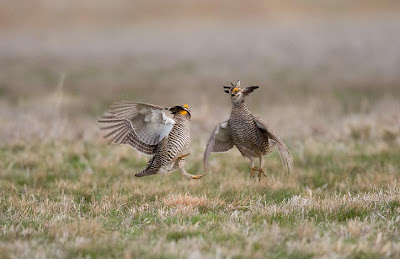
BY BILL GRAHAM
Kansas City Star
Kansas City Star
Eight lonesome male prairie chickens transplanted from Kansas to Missouri got some female company last week.
The native fowl are endangered in Missouri, and biologists are trying to re-establish a flock on the Wah'Kon-Tah Prairie near El Dorado Springs, Mo.
So in April, crews trapped prairie chickens at ranches in the Salina area and attached radio transmitters to them so they could be tracked.
Males were moved to Wah'Kon-Tah. But the females were left on their home range to raise chicks.
Then this month, crews trapped 52 more Kansas birds, hens and chicks, and moved them to Wah'Kon-Tah, said Max Alleger, a biologist for the Missouri Department of Conservation.
The last batch was released Tuesday. Research crews began tracking them Friday.
"We're trying to get a better idea of what kind of places they travel and feed in," Alleger said, "so we can put more of that habitat out there."
Prairie chickens grew scarce in Missouri as grasslands were converted to agriculture. Fewer than 500 native birds remain of what were once thousands.
Transplanting the ground-dwelling, grassland birds is one part of a broader recovery effort, Alleger said. Habitat improvement, especially on private lands, will be the biggest factor in saving them.
And if the effort succeeds at Wah'Kon-Tah, similar transplants could be done at other areas where prairie ecosystem improvements are taking root.
Wah'Kon-Tah is in the middle of a 5,000-acre mix of public and private land devoted to native grassland.
Alleger said he expects more transplants in coming years, and he hopes to see a growing flock by 2010, when the first chicks hatched are old enough to mate.
"That's going to be the time that we can see whether the birds are staying," he said.
Some males turned loose in April wandered to other prairies in the area, and some were tracked via their radio collars to sites more than 30 miles away.
One male traveled more than 80 miles round-trip from Wah'Kon-Tah to north of Fort Scott.
"We think having the females there now will keep them around better," Alleger said.
Left: "fighting cocks"
.jpg)






No comments:
Post a Comment